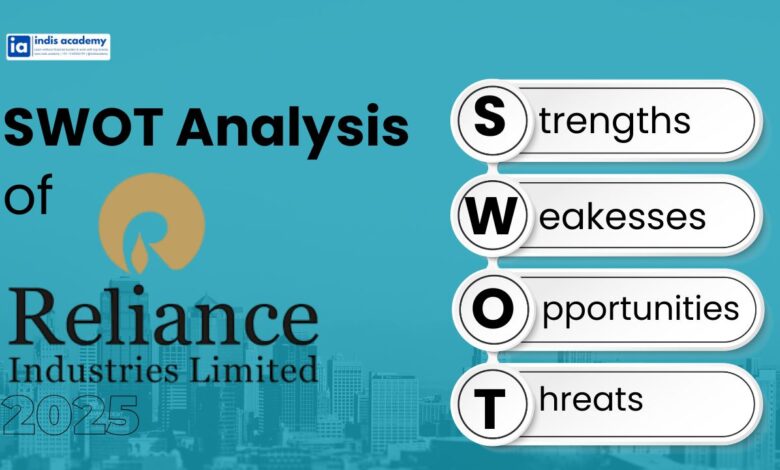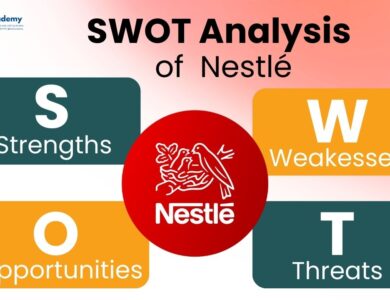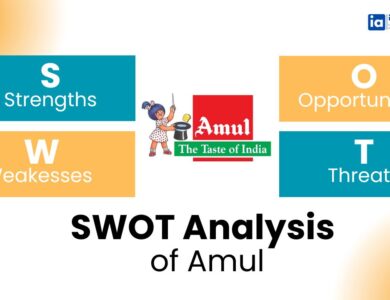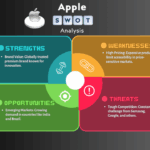SWOT Analysis of Reliance Industries (2025): Strategy, Strengths and Growth Outlook
Explore the complete SWOT analysis of Reliance Industries in 2025. Discover how India’s largest conglomerate is leveraging technology, retail, energy, and telecom to lead future growth—and what challenges lie ahead.

When it comes to shaping India’s economic future, few companies have been as impactful as Reliance Industries. From refining oil to rolling out the world’s lowest-cost telecom data, Reliance has consistently redefined industries—and created new ones.
In 2025, Reliance isn’t just an energy giant—it’s a digital, retail, green energy, and telecom powerhouse. Under the leadership of Mukesh Ambani, the company is aggressively investing in new-age sectors while holding strong in its traditional core.
But how well-positioned is Reliance to navigate the challenges of a rapidly changing India and a volatile global market?
In this blog, we’ll dive into a detailed SWOT analysis of Reliance Industries, examining its Strengths, Weaknesses, Opportunities, and Threats in 2025. Whether you’re a business student, investor, or industry observer—this analysis will help you understand where India’s biggest conglomerate stands today.
Learn AI & Digital Marketing,
Pay Fees After Placement
- ✅ Minimal Admission Fees
- ✅ No Loan or Income Sharing Agreement
- ✅ 100% Placement Support
- ✅ ISO & Govt Registered Certificate
- ✅ Practical 3+1 Months Duration
Get a free counseling call. We’ll guide you through learning, certification, and job placement.
Request a Free Call Back
Takes less than a minute.
Company Overview of Reliance Industries
Reliance Industries Limited (RIL) is India’s largest private-sector conglomerate, founded in 1973 by the visionary Dhirubhai Ambani. Today, under the leadership of Mukesh Ambani, Reliance has evolved into a diversified group operating across energy, retail, telecommunications, digital platforms, and now green energy.
Key Highlights (As of FY 2024–25):
- Headquarters: Mumbai, Maharashtra
- Market Capitalization: Over ₹18 lakh crore (~$220 billion)
- Annual Revenue: ₹10 lakh+ crore
- Employees: 350,000+ (direct and indirect)
Major Businesses:
- Reliance Retail – India’s largest retailer (grocery, electronics, fashion)
- Jio Platforms – India’s biggest telecom and digital services provider
- Oil-to-Chemicals (O2C) – Refining, petrochemicals
- Renewable Energy – Solar, green hydrogen, energy storage (Reliance New Energy)
Reliance’s long-term strategy is clear: transform from a traditional energy company into a digital and green energy-led future enterprise. With IPOs for Jio, Retail, and New Energy on the horizon, the next phase of Reliance is one of aggressive, diversified expansion.
What is a SWOT Analysis?
A SWOT analysis is a strategic framework used to evaluate a company’s competitive position by examining four key dimensions:
- Strengths – Internal advantages that drive growth and success
- Weaknesses – Internal challenges that could hinder performance
- Opportunities – External trends the company can leverage for expansion
- Threats – External risks that could disrupt operations or future plans
For a vast and complex business group like Reliance Industries, a SWOT analysis helps uncover what it does best, where it needs to adapt, and how it’s preparing to navigate future disruption—across multiple industries, from energy and telecom to retail and green tech.
It’s not just about current performance—it’s about strategic direction and resilience.
Strengths of Reliance Industries
Reliance isn’t just India’s largest conglomerate—it’s a masterclass in vertical integration, financial power, and strategic pivoting. From petrochemicals to Jio to green hydrogen, its ability to dominate and disrupt is unmatched.
Let’s break down the core strengths that fuel Reliance’s momentum in 2025:
1. Diversified Business Portfolio
Reliance operates across energy, telecom, retail, digital services, and now renewable energy. This diversification reduces dependency on any one sector and creates strong cross-industry synergies.
2. Market Leadership in Key Segments
- Jio is India’s largest telecom operator with over 450 million subscribers
- Reliance Retail is the top retailer by revenue and store count
- Its refining complex in Jamnagar is one of the largest in the world
This leadership gives Reliance enormous pricing power, customer access, and brand visibility.
3. Deep Financial Strength and Global Access to Capital
Reliance has repeatedly shown its ability to raise billions in funding through global investors like Facebook, Google, and sovereign wealth funds. Its low-cost capital access fuels aggressive expansion.
4. Visionary Leadership under Mukesh Ambani
Mukesh Ambani’s bold bets—from launching Jio to committing $75B toward green energy—have helped Reliance leapfrog competitors and disrupt industries.
5. Integration & Execution at Scale
Reliance controls the entire value chain—from production (oil, solar panels, data centers) to distribution (retail stores, Jio network, digital apps)—making it highly efficient and agile.
Read More:
- SWOT Analysis of Tata Group: Strength, Legacy & Future Strategy
- SWOT Analysis of Tesla: Innovation, Risks & Road Ahead for the EV Pioneer
- HDFC Bank SWOT Analysis: A Strategic Overview of India’s Banking Giant
- SWOT Analysis of Wipro: Strengths, Weaknesses, Opportunities & Threats
- SWOT Analysis of Flipkart (2025): Strengths, Weaknesses & E-Commerce Strategy in India
Competitor Comparison Table – 2025 Snapshot
| Company | FY25 Revenue (₹ Cr) | Key Sectors | Digital Footprint | Energy Transition Plan |
|---|---|---|---|---|
| Reliance | ₹10,00,000+ | Energy, Telecom, Retail, Green | Very Strong (Jio, apps) | Green hydrogen, solar |
| Adani Enterprises | ₹3,00,000+ | Infra, Energy, Data, Logistics | Growing | Solar, wind, data centers |
| Tata Group (Tata Sons) | ₹8,00,000+ | IT, Auto, Steel, Power, Retail | Medium–High (Tata Neu) | EVs, green power, ESG funds |
| Bharti Airtel | ₹1,50,000+ | Telecom, B2B, Payments Bank | Strong (Airtel Thanks) | Limited (vs Reliance) |
Data sourced from FY24–25 estimates and public filings
Reliance’s strength lies in being bigger, faster, and better funded than almost every competitor—while constantly reinventing its future roadmap.
Weaknesses of Reliance Industries
While Reliance commands massive market power, its aggressive expansion strategy and diversified bets come with internal risks that could impact operational efficiency and investor sentiment.
Let’s explore the key weaknesses of Reliance Industries in 2025:
1. Highly Capital-Intensive Business Model
Reliance’s ventures—whether in oil refining, 5G rollout, retail warehousing, or green energy—require enormous upfront capital. This exposes the company to debt cycles and long gestation periods, especially in uncertain macroeconomic environments.
2. Overdependence on Mukesh Ambani’s Vision
While Mukesh Ambani’s leadership has driven growth, centralized decision-making and limited public succession clarity could pose continuity risks in investor confidence, especially post-IPO plans of Jio and Retail.
3. Regulatory Headwinds in Key Verticals
Sectors like telecom and retail are heavily regulated. Reliance has often faced scrutiny around competition practices, licensing norms, and FDI limits, which could delay or disrupt business plans.
4. Legacy Dependence on Fossil Fuels
Despite pivoting to green energy, a large portion of Reliance’s revenues still come from oil-to-chemicals (O2C)—a segment that faces ESG concerns, global decarbonization pressure, and long-term demand risks.
5. Execution Risk in Green & Global Expansion
Reliance’s green energy vision is ambitious but unproven at scale. Challenges like tech implementation, global supply chains, and return on investment from solar, storage, and hydrogen ventures remain significant.
These weaknesses suggest that while Reliance is a visionary leader, it must maintain financial discipline, diversify leadership, and execute with precision to sustain long-term growth.
Opportunities for Reliance Industries
With India’s economy digitizing, decarbonizing, and expanding at a fast pace, Reliance Industries stands at the center of multiple growth frontiers. Its scale, capital strength, and tech-led vision create unmatched opportunities across sectors.
Here’s where Reliance can expand its dominance in 2025 and beyond:
1. Green Energy & Hydrogen Economy
Reliance has committed $75 billion to its New Energy division, focusing on:
- Green hydrogen production
- Gigafactories for solar panels, batteries, and fuel cells
- Carbon capture and storage technologies
This puts it in a strong position to lead India’s energy transition and become a global clean energy exporter.
2. Retail Expansion into FMCG & Private Labels
Reliance Retail is rapidly scaling its own brands and grocery verticals, entering spaces dominated by HUL, ITC, and D-Mart. Its JioMart + physical store + WhatsApp commerce strategy could disrupt both kirana stores and big-box retail.
3. Digital Platforms & Enterprise Tech
With Jio Platforms, Reliance can scale:
- Cloud services for Indian SMEs
- Video streaming (JioCinema), e-learning, and fintech
- AI + 5G-powered IoT applications in logistics, agriculture, and smart homes
4. IPO Opportunities for Value Unlocking
Planned IPOs for Jio, Retail, and Renewable Energy divisions could:
- Unlock significant shareholder value
- Attract foreign capital
- Allow business-specific growth without over-leveraging the parent company
5. Global Collaborations & Strategic Acquisitions
Reliance’s partnerships with Meta, Google, Microsoft, BP, and Saudi Aramco give it access to world-class tech, funding, and global expansion opportunities—particularly in digital infra, clean fuel, and cloud computing.
If Reliance executes across these opportunities, it can move from being India’s largest company to a global tech–energy–retail hybrid powerhouse.
Threats to Reliance Industries
Despite its unmatched scale and momentum, Reliance isn’t immune to external shocks and strategic risks. The company operates in highly dynamic industries—where regulations, competition, and global trends can quickly turn headwinds.
Here are the major threats Reliance faces in 2025:
1. Aggressive Competition from Conglomerates & MNCs
Reliance is up against:
- Adani Group in energy and infrastructure
- Amazon & Flipkart in retail and e-commerce
- Bharti Airtel and VI in telecom
- Tata Group in tech, retail, and EVs
Each is heavily funded and equally ambitious.
2. Policy & Regulatory Uncertainty
Frequent changes in telecom spectrum pricing, FDI norms in retail, and environmental regulations (especially around green energy) can disrupt expansion plans or increase compliance burdens.
3. Crude Oil Price Volatility & Geopolitical Risks
Reliance still relies significantly on its oil-to-chemicals business. Fluctuating crude prices, wars, or supply chain disruptions can hurt margins and increase input costs.
4. Execution Risk in Green & Digital Transformation
Entering sectors like green hydrogen, AI, and new-age cloud services requires deep expertise, stable regulation, and long gestation. Failure to scale these bets could strain financials and credibility.
5. Leadership Transition & Market Sentiment
While Mukesh Ambani has begun succession planning, investor confidence remains tied to his presence. Any shift in leadership without demonstrated competence from the next generation could impact stock sentiment and internal execution.
These threats underscore the need for Reliance to balance vision with agility, ensuring that growth does not outpace operational or regulatory alignment.
Strategic Insights & Key Takeaways
Reliance Industries is no longer just an oil-to-retail empire—it’s fast becoming a tech-enabled, green-energy-powered, consumer-centric powerhouse. But with such massive ambition comes the need for flawless execution, smart capital allocation, and agile leadership.
Here’s what the SWOT analysis reveals:
- Strengths like vertical integration, strong cash flow, and sector dominance make Reliance India’s most powerful conglomerate.
- Weaknesses such as high capital intensity and dependence on a single leadership vision must be carefully managed.
- Opportunities in green hydrogen, FMCG retail, and digital platforms position Reliance to lead India’s next wave of transformation.
- But threats from global uncertainty, competition, and regulatory shifts require constant vigilance and flexibility.
For Reliance to maintain its edge, it must continue building future-ready verticals, unlock value through strategic IPOs, and ensure succession stability across its leadership and vision.
Conclusion
Reliance Industries is more than just India’s biggest company—it’s a symbol of ambition, reinvention, and national transformation. From refining crude oil to refining digital lives through Jio, Reliance has repeatedly changed the way India consumes, communicates, and now—invests in the future.
But in 2025, the real story is about what comes next.
As it dives into green energy, AI-driven platforms, and consumer-first retail, Reliance must balance bold vision with precise execution. The SWOT analysis shows that while its foundation is rock-solid, its future depends on managing complexity, staying agile, and nurturing next-gen leadership.
If it gets that right, Reliance could shape not just India’s growth—but global trends in energy, retail, and digital connectivity.
❓ FAQs – SWOT Analysis of Reliance Industries
1. What is Reliance Industries best known for?
Reliance is best known for its leadership in oil refining, telecom (Jio), retail (Reliance Retail), and now green energy innovation.
2. What are Reliance’s most profitable business areas?
Historically, its oil-to-chemicals (O2C) division has driven profits. More recently, Jio Platforms and Retail are high-growth, high-margin segments.
3. Is Reliance investing in clean energy?
Yes. Through Reliance New Energy, the company is investing in solar, battery storage, and green hydrogen, aiming to become a global leader in clean tech by 2030.
4. What are the major challenges facing Reliance?
Key challenges include competition from Adani, policy risks, crude oil volatility, and executing large-scale transitions in green energy and digital platforms.
5. Will Reliance list its Jio and Retail businesses?
Yes, IPOs for Jio Platforms and Reliance Retail Ventures are expected in the near future to unlock value and attract strategic investors.





